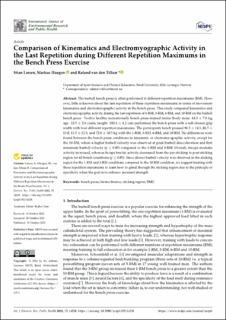| dc.contributor.author | Larsen, Stian | |
| dc.contributor.author | Haugen, Markus Estifanos | |
| dc.contributor.author | van den Tillaar, Roland Johannes Wilhelmus | |
| dc.date.accessioned | 2023-02-10T12:14:04Z | |
| dc.date.available | 2023-02-10T12:14:04Z | |
| dc.date.created | 2022-12-05T08:02:14Z | |
| dc.date.issued | 2022 | |
| dc.identifier.citation | Larsen, S., Haugen, M. & van den Tillaar, R. (2022). Comparison of kinematics and electromyographic activity in the last repetition during different repetition maximums in the bench press exercise. International Journal of Environmental Research and Public Health, 19(21), Article 14238. doi: | en_US |
| dc.identifier.issn | 1660-4601 | |
| dc.identifier.uri | https://hdl.handle.net/11250/3050014 | |
| dc.description.abstract | The barbell bench press is often performed at different repetition maximums (RM). However, little is known about the last repetition of these repetition maximums in terms of movement kinematics and electromyographic activity in the bench press. This study compared kinematics and electromyographic activity during the last repetition of 1-RM, 3-RM, 6-RM, and 10-RM on the barbell bench press. Twelve healthy recreationally bench press-trained males (body mass: 84.3 ± 7.8 kg, age: 23.5 ± 2.6 years, height: 183.8 ± 4.2 cm) performed the bench press with a self-chosen grip width with four different repetition maximums. The participants bench pressed 96.5 ± 14.1, 88.5 ± 13.0, 81.5 ± 12.3, and 72.8 ± 10.5 kg with the 1-RM, 3-RM, 6-RM, and 10-RM. No differences were found between the bench press conditions in kinematic or electromyographic activity, except for the 10-RM, where a higher barbell velocity was observed at peak barbell deacceleration and first minimum barbell velocity (p ≤ 0.05) compared to the 1-RM and 3-RM. Overall, triceps medialis activity increased, whereas biceps brachii activity decreased from the pre-sticking to post-sticking region for all bench conditions (p ≤ 0.05). Since slower barbell velocity was observed in the sticking region for the 1-RM and 3-RM conditions compared to the 10-RM condition, we suggest training with these repetition maximums to learn how to grind through the sticking region due to the principle of specificity when the goal is to enhance maximal strength. | en_US |
| dc.language.iso | eng | en_US |
| dc.publisher | MDPI | en_US |
| dc.rights | Navngivelse 4.0 Internasjonal | * |
| dc.rights.uri | http://creativecommons.org/licenses/by/4.0/deed.no | * |
| dc.title | Comparison of kinematics and electromyographic activity in the last repetition during different repetition maximums in the bench press exercise | en_US |
| dc.type | Peer reviewed | en_US |
| dc.type | Journal article | en_US |
| dc.description.version | publishedVersion | en_US |
| dc.rights.holder | © 2022 The Authors | en_US |
| dc.source.pagenumber | 10 | en_US |
| dc.source.volume | 19 | en_US |
| dc.source.journal | International Journal of Environmental Research and Public Health (IJERPH) | en_US |
| dc.source.issue | 21 | en_US |
| dc.identifier.doi | 10.3390/ijerph192114238 | |
| dc.identifier.cristin | 2088365 | |
| dc.source.articlenumber | 14238 | en_US |

